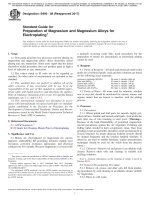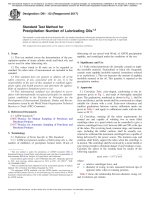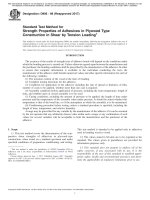Astm d 612 88 (2017)
Bạn đang xem bản rút gọn của tài liệu. Xem và tải ngay bản đầy đủ của tài liệu tại đây (120.75 KB, 4 trang )
This international standard was developed in accordance with internationally recognized principles on standardization established in the Decision on Principles for the
Development of International Standards, Guides and Recommendations issued by the World Trade Organization Technical Barriers to Trade (TBT) Committee.
Designation: D612 − 88 (Reapproved 2017)
Standard Test Method for
Carbonizable Substances in Paraffin Wax1
This standard is issued under the fixed designation D612; the number immediately following the designation indicates the year of
original adoption or, in the case of revision, the year of last revision. A number in parentheses indicates the year of last reapproval. A
superscript epsilon (´) indicates an editorial change since the last revision or reapproval.
This standard has been approved for use by agencies of the U.S. Department of Defense.
1. Scope
3. Summary of Test Method
1.1 This test method covers determination of carbonizable
substances in paraffin wax. The test method is applicable to
paraffin wax for pharmaceutical use, as defined by the U.S.
National Formulary, with a melting point as determined in
accordance with Test Method D87, between 117 °F and 149 °F
(47 °C and 65 °C).
3.1 Five millilitres of melted wax are treated with 5 mL of
concentrated, nitrogen-free sulfuric acid at 158 °F (70 °C). The
color of the acid layer is compared with that of a colorimetric
reference standard. If the color is not darker than the standard,
the wax is reported as passing the test.
4. Significance and Use
1.2 The values stated in inch-pound units are to be regarded
as standard. The values given in parentheses are mathematical
conversions to SI units that are provided for information only
and are not considered standard.
1.3 This standard does not purport to address all of the
safety concerns, if any, associated with its use. It is the
responsibility of the user of this standard to establish appropriate safety and health practices and determine the applicability of regulatory limitations prior to use. Specific warning
statements are given in Annex A1.
1.4 This international standard was developed in accordance with internationally recognized principles on standardization established in the Decision on Principles for the
Development of International Standards, Guides and Recommendations issued by the World Trade Organization Technical
Barriers to Trade (TBT) Committee.
4.1 This test method is a means for ascertaining whether
pharmaceutical paraffin wax conforms to the standards for
quality prescribed by the U.S. National Formulary.
5. Apparatus
5.1 Test Tube, as shown in Fig. 1, of heat-resistant glass (see
Note 1) fitted with a well-ground glass stopper, the stopper and
the tube bearing identical and indestructible numbers. The tube
shall be 140 mm 6 2 mm in length and between 14.5 mm and
15.0 mm in outside diameter, and shall be calibrated at the
5 mL 6 0.2 mL and 10 mL 6 0.2 mL liquid levels. The
capacity of the tube with stopper inserted shall be between
13.6 mL and 15.6 mL. A rolled edge may be provided for
suspending the tube on the cover of the water bath.
NOTE 1—Borosilicate glass has been found satisfactory for this purpose.
2. Referenced Documents
5.2 Water Bath, suitable for immersing the test tube above
the 10 mL line and equipped to maintain a temperature of
158 °F 6 1.0 °F (70 °C 6 0.5 °C). The bath shall be provided
with a cover of any suitable material, with holes approximately
16 mm in diameter through which the test tubes may be
suspended.
2
2.1 ASTM Standards:
D87 Test Method for Melting Point of Petroleum Wax
(Cooling Curve)
D1193 Specification for Reagent Water
5.3 Color Comparator, of a suitable type for observing the
color of the acid layer in comparison with the reference
standard color solution. The size and shape of the comparator
are optional, but the size and shape of the apertures shall
conform to the dimensions prescribed in Fig. 1.
1
This test method is under the jurisdiction of ASTM Committee D02 on
Petroleum Products, Liquid Fuels, and Lubricants and is the direct responsibility of
Subcommittee D02.10.0A on Physical/Chemical Properties.
Current edition approved June 1, 2017. Published July 2017. Originally approved
in 1941. Last previous edition approved in 2012 as D612 – 88 (2012). DOI:
10.1520/D0612-88R17.
2
For referenced ASTM standards, visit the ASTM website, www.astm.org, or
contact ASTM Customer Service at For Annual Book of ASTM
Standards volume information, refer to the standard’s Document Summary page on
the ASTM website.
6. Reagents
6.1 Purity of Reagents—Reagent grade chemicals shall be
used in all tests. Unless otherwise indicated, it is intended that
Copyright © ASTM International, 100 Barr Harbor Drive, PO Box C700, West Conshohocken, PA 19428-2959. United States
1
D612 − 88 (2017)
FIG. 1 Color Comparator for Carbonizable Substances in Liquid Petrolatum
6.4 Colorimetric Reference Standard Solution—Prepare a
reference standard pale amber solution for color comparison by
mixing together 1.5 parts of CoCl2 solution, 3.0 parts of FeCl3
solution, and 0.5 parts of CuSO4 solution. Measure 5 mL of
this mixture into a test tube as specified in 3.1. This pale amber
reference standard shall then be overlaid with 5 mL of white
mineral oil.
all reagents shall conform to the specifications of the Committee on Analytical Reagents of the American Chemical Society,
where such specifications are available.3 Other grades may be
used, provided it is first ascertained that the reagent is of
sufficiently high purity to permit its use without lessening the
accuracy of the determination.
6.2 Purity of Water—Unless otherwise indicated, references
to water shall be understood to mean distilled water, such as
reagent water corresponding to Specification D1193, Type III,
or water of equal purity.
6.5 Cupric Sulfate Solution (0.5 N)—Dissolve about 65 g of
cupric sulfate (CuSO4·5H2O) in enough diluted HCl (1 + 39)
(Warning—Hydrochloric acid (concentrated) causes burns,
vapor extremely irritating. See A1.2) to make 1000 mL of
solution. Transfer exactly 10 mL of this solution to a flask, add
50 mL of water, 4 mL of acetic acid (Warning—Acetic acid
(glacial) is corrosive, combustible, vapor irritating. See A1.5),
and 3 g of KI. Allow the mixture to stand for 5 min, then titrate
the liberated iodine with 0.1 N Na2S2O3 solution, using starch
solution as an indicator. Each millilitre of 0.1 N Na2S2O3
solution is equivalent to 0.02497 g of CuSO4·5H2O. Adjust the
final volume of CuSO4 solution by the addition of diluted HCl
(1 + 39) so that 1 mL contains 62.4 mg of CuSO4·5H2O.
6.3 Cobaltous Chloride Solution (0.5 N)—Dissolve about
65 g of cobaltous chloride (CoCl2·6H2O) in enough diluted
hydrochloric acid (HCl, 1 + 39) (Warning—Hydrochloric acid
(concentrated) causes burns, vapor extremely irritating. See
A1.2) to make 1000 mL of solution. Transfer exactly 5 mL of
this solution to a flask; add 15 mL of sodium hydroxide
(NaOH, 1 + 5) (Warning—Sodium hydroxide, corrosive, can
cause severe burns or blindness. Evolution of heat produces a
violent reaction or eruption upon too rapid a mixture with
water. See A1.4), and 5 mL of hydrogen peroxide. Boil for
10 min, cool, and add 2 g of potassium iodide (KI) and 20 mL
of sulfuric acid (H2SO4, 1 + 4) (Warning—Sulfuric acid
(concentrated) causes burns, vapor irritating, strong oxidizer.
See A1.3). When the precipitate has dissolved, titrate the
liberated iodine with 0.1 N sodium thiosulfate (Na2S2O3)
solution using starch solution as an indicator. Each millilitre of
0.1 N Na2S2O3 solution consumed is equivalent to 0.023799 g
of CoCl2·6H2O. Adjust the final volume of CoCl2 solution by
the addition of diluted HCl (1 + 39) so that 1 mL contains
59.5 mg of CoCl2·6H2O.
6.6 Ferric Chloride Solution (0.5N)—Dissolve about 55 g
of ferric chloride (FeCl3·6H2O) in enough diluted HCl
(Warning—Hydrochloric acid (concentrated) causes burns,
vapor extremely irritating. See A1.2) (1 + 39) to make
1000 mL of solution. Transfer exactly 10 mL of the solution to
a flask, add 5 mL of HCl (sp gr 1.19), 25 mL of water, and
about 3 g of KI. Stopper and allow the mixture to stand for
5 min. Dilute the mixture with 50 mL of water, and titrate the
liberated iodine with 0.1 N Na2S2O3 solution, using starch
solution as an indicator. Each millilitre of 0.1 N Na2S2O3
solution is equivalent to 0.02703 g of FeCl3·6H2O. Adjust the
final volume of the FeCl3 solution by the addition of diluted
HCl (1 + 39) so that 1 mL contains 45.0 mg of FeCl3·6H2O.
3
Reagent Chemicals, American Chemical Society Specifications, American
Chemical Society, Washington, DC. For Suggestions on the testing of reagents not
listed by the American Chemical Society, see Annual Standards for Laboratory
Chemicals, BDH Ltd., Poole, Dorset, U.K., and the United States Pharmacopeia
and National Formulary, U.S. Pharmacopeial Convention, Inc. (USPC), Rockville,
MD.
6.7 Sulfuric Acid (94.7 6 0.2 %)—The sulfuric acid
(H2SO4) (Warning—Sulfuric acid (concentrated) causes
burns, vapor irritating, strong oxidizer. See A1.3) shall be
2
D612 − 88 (2017)
the color comparator, and compare the acid layer with 5 mL of
the standard colorimetric solution and 5 mL of white mineral
oil in a test tube that has been shaken vigorously for 10 s and
allowed to stand just long enough for the contents to separate
into two layers.
nitrogen-free when analyzed in accordance with the following
procedure: Dilute a small amount of the acid with an equal
volume of water and superimpose 10 mL of the cooled liquid
upon diphenylamine solution (1 g of diphenylamine in 100 mL
of concentrated H2SO4). A blue color should not appear at the
zone of contact within 1 h. This test detects as little as
0.0002 % NO3.
7.5 In some cases the acid remains trapped with the wax as
an emulsion, and no lower layer is obtained to compare with
the standard colorimetric solution. When this occurs, compare
the emulsion with the standard colorimetric solution and white
mineral oil shaken vigorously to give a similar emulsion, and
without waiting for the two liquids to separate.
7. Procedure
7.1 Clean a test tube with cleaning solution of sulfuric acid
and Nochromix4 (Warning—Nochromix4 is corrosive. See
A1.1), rinse with tap water followed by distilled water, and dry
in an oven at 105 °C for 1 h.
8. Interpretation of Results
7.2 Melt a representative portion of the sample on a steam
bath or hot water bath. Fill the test tube to the 5 mL mark with
H2SO4 (94.7 % 6 0.2 %). Then add the melted wax, at a
temperature not more than 10 °F (5.5 °C) above its melting
point, to the 10 mL mark, insert the stopper loosely, and place
the test tube in position in the water bath at 158 °F 6 1.0 °F
(70 °C 6 0.5 °C).
8.1 Paraffin wax shall be reported as passing the test when
the acid layer is not darker than the reference standard
colorimetric solution or, if completely emulsified, when the
emulsion is not darker than a similar emulsion produced by
vigorously shaking the reference standard colorimetric solution
with white mineral oil in equal proportions.
8.2 If the acid layer is darker than the reference standard
colorimetric solution, or if the emulsified paraffin wax and acid
are darker than a similar emulsion of the reference standard
colorimetric solution and white mineral oil in equal
proportions, the paraffin wax shall be reported as not passing
the test.
7.3 After the test tube has been in the water bath for 5 min,
loosen the stopper sufficiently to release any pressure and
reinsert, remove the test tube from the bath quickly, hold with
a finger over the stopper, and give three vigorous, vertical
shakes over an amplitude of about 5 in. (127 mm), shaking the
test tube quickly and at a rate corresponding to 5 shakes/s.
Repeat every minute. Do not keep the test tube out of the bath
longer than 3 s for each shaking period.
9. Precision and Bias
9.1 No statement is made about either the precision or the
bias of this test method for measuring carbonizable substances
in white refined waxes since the result only states whether there
is conformance to the criteria for success specified in the
procedure.
NOTE 2—A shaking machine may be used provided that the results
obtained agree with those obtained by the prescribed manual agitation.
7.4 At the end of 10 min from the time the test tube was first
placed in the bath, remove the test tube, immediately place it in
10. Keywords
4
Nochromix is a trademark of Godax Laboratories, Inc., P.O. Box 422, Cabin
John, MD 20818.
10.1 carbonizable substances; petroleum wax; wax
ANNEX
(Mandatory Information)
A1. WARNING STATEMENTS
A1.1 Glass Cleaning Solution (Nochromix4)
A1.1.1 Warning—Corrosive, potent, clear liquid. Solution
is a mixture of sulfuric acid (concentrated) and Nochromix,4 a
white crystalline, inorganic oxidizer.
Handle carefully with special highly acid resistant gloves
only.
Do not close container airtight.
Do not get in eyes, on skin, or on clothing.
Do not breathe vapor, spray, or mist.
Dilute by addition of acid to water.
Keep in tightly closed container in approved acid storage
cabinet.
Keep cool.
Loosen closure carefully when opening.
Use with adequate ventilation.
Keep container closed when not in use.
Use protective clothing and goggles when handling.
Wash thoroughly after handling.
A1.2 Hydrochloric Acid (Concentrated)
A1.2.1 Warning—Poison. Corrosive. May be fatal if swallowed. Liquid and vapor cause severe burns. Harmful if
inhaled.
3
D612 − 88 (2017)
When handling, use chemical safety goggles or face shield,
protective gloves, boots, and clothing.
When mixing with water, add slowly to surface of solution
to avoid violent spattering. In the preparation of solutions do
not use hot water, limit temperature rise, with agitation, to
10°C/min or limit solution temperature to a maximum of
90 °C. No single addition should cause a concentration increase greater than 5 %.
A1.3 Sulfuric Acid (Concentrated)
A1.3.1 Do not get in eyes, on skin or on clothing.
Do not breathe vapor, spray, or mist.
Dilute by addition of acid to water.
Keep in tightly closed container in approved acid storage
cabinet.
Keep cool.
Loosen closure carefully when opening.
Use with adequate ventilation.
Do not allow water to get into container because of violent
reaction.
Keep container closed when not in use.
Use protective clothing and goggles when handling.
Wash thoroughly after handling.
A1.5 Acetic Acid (Glacial)
A1.5.1 Do not get in eyes, on skin, or on clothing.
Do not breathe vapor, spray or mist.
Dilute by addition of acid to water.
Keep away from heat and open flame.
Keep in tightly closed container in approved acid storage
cabinet.
Keep cool.
Loosen closure carefully when opening.
Use with adequate ventilation.
Keep container closed when not in use.
Use protective clothing and goggles when handling.
Wash thoroughly after handling.
A1.4 Sodium Hydroxide
A1.4.1 Before using, secure information on procedures and
protective measures for safe handling.
Do not get in eyes, on skin, or on clothing.
Avoid breathing dusts or mists.
Do not take internally.
ASTM International takes no position respecting the validity of any patent rights asserted in connection with any item mentioned
in this standard. Users of this standard are expressly advised that determination of the validity of any such patent rights, and the risk
of infringement of such rights, are entirely their own responsibility.
This standard is subject to revision at any time by the responsible technical committee and must be reviewed every five years and
if not revised, either reapproved or withdrawn. Your comments are invited either for revision of this standard or for additional standards
and should be addressed to ASTM International Headquarters. Your comments will receive careful consideration at a meeting of the
responsible technical committee, which you may attend. If you feel that your comments have not received a fair hearing you should
make your views known to the ASTM Committee on Standards, at the address shown below.
This standard is copyrighted by ASTM International, 100 Barr Harbor Drive, PO Box C700, West Conshohocken, PA 19428-2959,
United States. Individual reprints (single or multiple copies) of this standard may be obtained by contacting ASTM at the above
address or at 610-832-9585 (phone), 610-832-9555 (fax), or (e-mail); or through the ASTM website
(www.astm.org). Permission rights to photocopy the standard may also be secured from the Copyright Clearance Center, 222
Rosewood Drive, Danvers, MA 01923, Tel: (978) 646-2600; />
4









